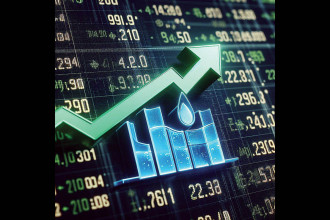
Trading in the commodity markets is not for the faint hearted. The markets change in a blink of the eye. Factoring unexpected change in your trading system will prove to be the light at the end of the tunnel. However, the markets have every now and then ushered a knack for an ‘expect the unexpected’ mentality. While on one hand, the stock markets have stabilised and with it the returns, if a trader is all out for action, the commodity market has traditionally been a perfect platform. With wild price swings, massive cycles, resource discoveries and extreme weather patterns driving the prices, there is never a dull day in this industry. As we cross the first half of the year, it is only apt that we review the commodity market and identify the major movers and shakers atthe half way mark.
Out of all the tradable commodities, wheat inclined to take the top spot for the first half of 2017, returning more than 25 percent in the process. Palladium was not far away from the race gaining by a mammoth 24 percent. In the bearish corner, natural gas took the cake with a negative 18.89 percent followed by crude oil recording 15 percent negative returns.
Vivek Risal is associated with Mercantile Exchange Nepal Limited in the capacity of Manager in Research and Development Department. He can be contacted at r&[email protected]
Metals
Given the modest gains in 2016, gold commenced 2017 at $1150.33 per troy ounce. However, the prices leaped forward increasing to the highest price of $1295.81 per troy ounce in June. At half time, gold had recorded a positive return of 7.89%. Gold had twice tested the $1296 resistance point on 16 April and 6 June but failed to break the level on both occasions. Although the rate hikes by the Federal Reserve did manage to dent the expectations of a bullish trend, gold was supported largely by strong demand in the Indian markets as consumers made their purchases ahead of the implementation of the Goods and Services Tax (GST) on July 1, levying a 3 percent tax on gold. The impact of the demonetisation implemented in December 2016 pushed trader confidence away from fiat currencies, reaffirming their faith in the bullion as a store of value. Silver benefitted from the limited supply, climbing nearly 4.5 percent. In May, The Silver Institute reported a decline in the global silver mine production in 2016 for the first time in 14 years. This factor along with others drove silver to attain the highest price of $18.63 per troy ounce on 16 April. However, the prices have fallen since then closing at $16.61 per troy ounce on 30 June. Platinum prices also inclined by 2% to close at $921.7 per troy ounce having commenced the year at $900 per troy ounce. The prices had skyrocketed to the highest of $1043.01 per troy ounce on 27 February but had declined thereafter. In the first half of 2017, palladium surged to a 16-year high, making it the second highest in returns following wheat. Having started at $678 per troy ounce in 2017, prices had inclined to the highest price of $910.95 per troy ounce on 9 June before closing at $841.19 per troy ounce. Palladium, the silvery white metal used in the production of catalytic converters, is one of the rarest metals on earth and mined mostly in Russia and South Africa. The price of palladium is extremely vulnerable to such speculative trading and has achieved near-price parity with its sister metal, platinum, for the first time in two decades. Driving the palladium rally was the European car buyers who were stating that soon they would switch from diesel-burning to gas-burning because of emission concerns. Copper witnessed a modest gain having started the year at $2.4990 per pound in 2017. The prices inclined by 7.71 percent to close at $2.6918 per pound.Energy
When OPEC embarked on the historic decision to stabilise the markets by limiting the supply in 2016, the markets were structured for a rise. However, oil has witnessed a bearish pattern with the prices falling by a mammoth 15 percent since beginning the year at $53.81 per barrel. The fall was mostly attributed to US shale producers who were quick to reactivate dormant rigs following the decision by OPEC. The market has been, in hindsight, awash in black gold. The Energy Information Administration in May announced that domestic output averaged 9.3 million barrels per day this year, a level unseen in the US since the 1970s. Natural gas declined the most in the first half of the year. Starting at $3.758 per MMBTU, the price had declined by 18.89 percent to slump to $3.048 per MMBTU by the end of June. Favorable weather patterns across the USA thwarted the demand of the energy product which is mostly used during extreme weather conditions.Agro
The US reclaimed its long standing position as the number one wheat exporters this year displacing Russia to number two. However, prices skyrocketed during the review period, as a report from the US Department of Agriculture (USDA) stated that American farmers are not planting wheat like they used to. Shrinking in the acreage coupled with more and more farmers switching to soybeans lead to the rise in the prices. Also severe to extreme weather in the Northern Plains across the US led to less harvesting and prices jumped by 25 percent to a nearly two year high. While cotton and corn inclined by 5 percent and 2 percent respectively in the first half, other agro-commodities including soybean, coffee, sugar and cocoa declined during the same period.The Road Ahead
Traders will be looking forward to the second half of the year as the first half has witnessed a general slump in the prices across most commodities. With scores of important political events emancipating from various economies across the globe, traders will be keeping a close eye as we step onto the second half of 2017.Vivek Risal is associated with Mercantile Exchange Nepal Limited in the capacity of Manager in Research and Development Department. He can be contacted at r&[email protected]
Published Date: August 13, 2017, 12:00 am
Post Comment
E-Magazine
RELATED Commodity Perspective





